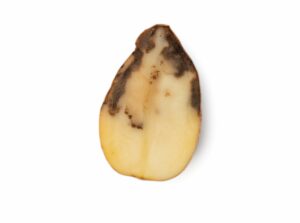Australia free of type A2 potato late blight
Most potato growers will be familiar with potato late blight. This devastating disease affects potato production around the world. Yet, thanks to robust biosecurity measures, Australia has been able to keep out more aggressive strains of this disease.
Overview of Phytophthora infestans
The potato disease late blight is caused by the fungal-like pathogen Phytophthora infestans.
Late blight is now present across the globe, destroying around 5% of potato crops every year. As a water-mould (oomycete), P. infestans spores require water to germinate and spread to other plants. As a result, the disease thrives under moderate weather conditions with cool nights, which can typically be associated with La Nina events in Australia. Crop losses of up to 100 per cent are not uncommon when the disease goes unmanaged.
In many parts of Europe and North America, late blight has been wreaking havoc for potato producers. In the Netherlands, the worst outbreak in 30 years occurred during 2023, with the current 2024 season not looking promising. Growers have had to apply a large quantity of fungicides, leading to rapidly evolving fungicide resistance issues and the breakdown of genetic disease resistances within cultivars. Moreover, a new, more aggressive strain of the disease has recently been identified, leading to further disease management complications.
Late blight types – A1 and A2
Several different strains of the disease exist around the world. For P. infestans there are two mating types: A1 and A2. The A2 mating type is a newer strain of the disease, originating from Mexico. But most importantly, if mating types A1 and A2 are both present in a crop, they may recombine through sexual reproduction. This will give rise to a potentially even more aggressive disease and may evolve into fungicide resistance.
Most importantly, it will allow the disease to survive for extended periods in the soil through the presence of oospores: sexual spores resulting from the recombination of mating type A1 and A2. These oospores are capable of dormancy and survival in the soil, infected plant debris and tubers, and can be spread on contaminated soil on boots and farm machinery. Since the first identification of mating type A2 in Europe, the mating type has rapidly spread between countries and even continents.
Fortunately, only mating type A1 is known to be present in Australia. More specifically, there is only one strain present, which has remained unchanged since it was first discovered during the early 1900s. This means, that in Australia, the disease can currently be managed well by applying good farm hygiene, certified seed potatoes, the use of resistant cultivars and applications of appropriate fungicides. Overseas, new strains and recombinant P. infestans populations quickly developed resistance against metalaxyl, whereas the Australian strain remains sensitive to this fungicide.
What are the symptoms of late blight?
Late blight infection causes pale-grey lesions to appear on the leaf margins. These spots rapidly progress into larger necrotic lesions, which are not limited by leaf veins. Within days, the leaves turn yellow and die. P. infestans may also affect the stems. White fungal growth may be present on the underside of the leaves or the stem.
Affected tubers will show a tannish-brown, reddish, or purplish coloured rot, with irregularly sunken areas. Secondary bacterial infection may cause further disease and breakdown. P. infestans primarily affects potatoes, but other solanaceous plants, such as volunteer potatoes and tomatoes, can be an alternative host and may act as a reservoir for the disease.
How do I recognise exotic strains of late blight?
Both endemic and exotic P. infestans strains cause the same disease symptoms. However, exotic strains are likely to be more aggressive; infection cycles may shorten to three to five days. Disease may also occur under different weather conditions than what would normally be expected. For example, weather conditions may be warmer, cooler or drier for exotic strains. It is also possible that exotic strains carry resistance to metalaxyl, and as such, fungicides with this active ingredient may no longer be effective.
If you suspect an exotic strain of late blight in your crop, report it to the Exotic Plant Pest Hotline.
Biosecurity works!
While disease caused by P. infestans can be devastating, there are some positive aspects. It is a great example of how national biosecurity regulations, in conjunction with good on-farm biosecurity practises, have kept Australia free from exotic strains of P. infestans for many years.
On a national level, new potato cultivars may only be imported through tissue cultured plantlets. Tourists and returning residents are required to declare any overseas farm visits and thorough cleaning and disinfection of footwear is mandatory.
On a farm level, there are several things that you can do to keep your farm safe:
- Implement good farm biosecurity practices.
- Always use healthy, certified seed potatoes to prevent introducing pathogens through infected tubers.
- Implement farm hygiene and biosecurity practices to reduce the spread of inoculum. Remove plant waste and consider the disease may survive on volunteer potatoes or other solanaceous crops.
- Use late blight resistant cultivars.
- Apply and rotate fungicides appropriately to protect your crop.
For more information visit PotatoLink at www.potatolink.com.au
 The name Phytophthora is derived from the ancient Greek language and translates as ‘plant destroyer’. The pathogen is infamous as the causative agent for the Irish Potato Famine (1845-1849), decimating the Irish population. An estimated one million people died because of the famine, and many more migrated to different countries.
The name Phytophthora is derived from the ancient Greek language and translates as ‘plant destroyer’. The pathogen is infamous as the causative agent for the Irish Potato Famine (1845-1849), decimating the Irish population. An estimated one million people died because of the famine, and many more migrated to different countries.



